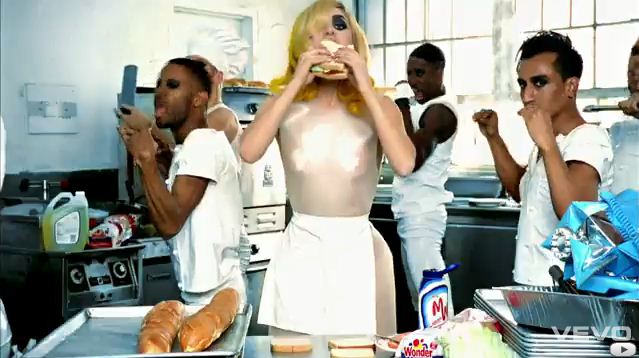“You might be too distracted to notice the first time through, but there is actually a lot of food imagery used in the Telephone music video.” And so, for the first time, I scrutinized a Lady Gaga video not for the outrageously skimpy outfits, but for the usage of food items. At the end of the ten minutes, our class was taken aback at the number of product placements in the film short. “It’s just a big ad for Virgin, Honey Buns and Polaroid, isn’t it?” The video makes frequent use of ersatz, convenience products like WonderBread and Miracle Whip. “Lady Gaga is well aware of her status as a highly commercial icon, and makes no pretense of acting otherwise. In a sense, she has tricked you into watching a 10-minute long ad masquerading as music video, one that you will now send to all your friends.” And what’s with the Diet Coke can hair rollers? In modern society, the panopticon of body image compels women to diet and lose weight, even without explicit pressure. She is trapped by both an interior and exterior prison.
Our professor was Fabio Parasecoli, from the department of nutrition, food studies and public health at NYU, and he deftly guided us through the semiotics of food symbolism and a post-structuralist analysis of consumer body image perceptions. Power relations are negotiated through the acceptance or refusal of food, and race and sex differences are mediated through cooking and eating food. Food embodies the person who prepared it, as seen in the rejection of the “AIDS Burger” in True Blood, and it can be used as cultural capital to differentiate yourself or elevate your social status. At the consumerist extreme, food is produced for a society of spectacle, with much of food programming on TV designed for people who will never pick up a knife or walk into a kitchen.
At the end of the class, we were tasked to discuss and analyze a pop culture item that involves food. After batting around a number of ideas (“Idealized Body Image and the Subversive Politics of This Is Why You’re Fat,” “Exploiting the DD Tomato: the Explosion of Food Porn on the Web”), I decided to write about the annual Washington Post Peeps Diorama contest. This competition involves constructing a diorama with marshmallow Peeps, and the entries reflect the cross-section of pop culture at that point in time. Topics range from the serious (Korean War Memorial) to the cheeky (“Peeps and Prejudice and Zombies,” a play on the novel “Pride and Prejudice and Zombies,” which is itself a parody of the Jane Austen work).
Here’s an excerpt from the paper, “The United State of Pop: A Peep Show.”
Perhaps even more interesting than the winning dioramas are the dioramas that are deemed too controversial for public display. In 2009, one of the semifinalists depicted a waterboarding scene at Guantanamo Bay, which sparked some backlash from readers. In response to criticism that the selection “celebrated” the use of torture, Washington Post journalist and judge Dan Zak commented, “I don’t think the diorama is celebrating Guantanamo Bay. It is depicting it using an absurd medium. It’s low-grade satire. A Peeps diorama of Guantanamo Bay makes us chuckle, but there’s a dose of bitter shame behind it. When first viewed by the staff here, it elicited laughs that turned quickly to groans. And we’ve had Abu Ghraib submissions. We’ve had an execution of Saddam Hussein Peep diorama. Crucifixion dioramas. And so on. But this Guantanamo one was edgy, amusing, topical and groan-inducing. And it got the OK from editors.” The inherent humor of the Peeps medium has made the parody of a politically sensitive subject socially acceptable.
Finally, one last Peep diorama, a depiction of the Wedding Entrance Dance video that went viral last year.



I’m enthralled!
Well, a lot of music videos appear like ads these days (I remember the vids of Puff Daddy–yes, Puff Daddy not Diddy yet, wherein I could sit down for 4 minutes and those 4 minutes filled with luxury cars, brands, explosives; you name it, all are present in a video. Such videos present a different set of ideals to their audience ). A lot of celebrities know their power to sell, and in this glory age of hyperconsumerism, those who play the game surely would take advantage of this moment. They can use food symbolism, spectacle and etc. At the end of the day, all these boil down to commerce.